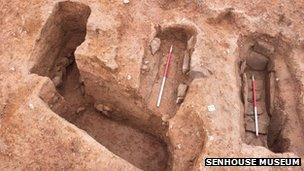Roman dig reveals early Christian graves
- Published

The discoveries were in "remarkable condition"
Early Christian graves recently unearthed by archaeologists are to be the highlight of daily tours of Maryport Roman fort.
Visitors to Senhouse Roman Museum, external, which is at the fort, will find out what happens during excavations.
They will also be able to see recently unearthed evidence of Christian graves during the daily tours until 14 August.
A spokesman for the museum said the discovery of the graves was exciting and shed "new light" on the Dark Ages.
Remnants from the grave include bone fragments, caps of tooth enamel, and a thumbnail-sized piece of textiles.
Peter Greggains, of the Senhouse Museum Trust, said: "The Maryport site's importance as a unique and valuable resource capable of providing information about the remote past has been established beyond doubt, and we now have new light on the Dark Ages."
Child's grave
Tony Wilmot, site director said: "It will take a while to process all the information following the dig, but what we think we're looking at now is a Christian cemetery close to a sequence of Christian religious buildings.
"If this is the case, then this is a very exciting discovery - an early post-Roman Christian religious site occupied at the same time as other famous early Christian sites at Whithorn and Hoddom in nearby Dumfriesshire."
A number of graves have been revealed, and it is believed a very small stone-lined grave is the resting place of a child.
The dig site will be open to visitors from 1100 BST to 1600 BST to 14 August.
- Published18 July 2012
- Published16 July 2011
- Published31 May 2011